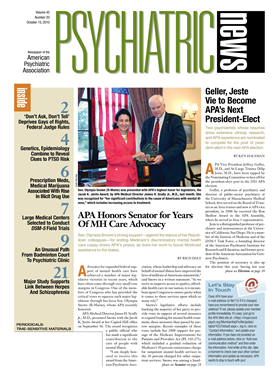My article in the series on DSM-5 activity that began in the October 1 Psychiatric News introduced readers to the DSM-5 field trials—a vital component to developing diagnostic criteria that involves taking the proposed revisions from each of the 13 DSM-5 work groups into the field to observe their impact on diagnosis and patient care. As noted, having practitioners such as solo clinicians and those in independent group practices test proposed revisions is important for examining DSM-5 in the context of its everyday use. However, it is equally important that draft criteria are examined in sizable, diverse populations as well.
Large academic medical institutions usually house general psychiatric as well as specialty clinics, such as pediatric psychiatry clinics or substance use treatment clinics. This makes them a popular choice among patients. Those institutions' affiliation with medical school training programs means an abundance of available clinicians, as well as the necessary infrastructure for conducting clinical research. As a result, these large settings provide an ideal backdrop for recruiting high volumes of psychiatric patients who represent a wide array of characteristics, including various ages, cultures and ethnicities, socioeconomic backgrounds, and potential diagnoses. DSM-5's developers recognize the importance of recruiting broad samples of patients, and this is reflected in the DSM-5 field trials using two distinct designs—the routine clinical practice design described in my previous article and a second design for large, academicmedical settings.
In May, APA began soliciting applications from institutions interested in serving as potential recruitment sites for the large-setting design. After receiving approximately 60 submissions, 11 institutions were chosen. The selection was based on a number of factors, including patient volume, clinician staffing, and the prevalence and types of mental disorders typically seen in the setting. Among the 11 institutions are four sites that will recruit pediatric and adolescent samples only. They are the New York State Psychiatric Institute at Columbia University Medical Center in New York City; Baystate Medical Center in Springfield, Mass.; Children's Hospital in Aurora, Colo.; and Lucile Packard Children's Hospital at Stanford University in Stanford, Calif.
The remaining seven sites will recruit adult and geriatric participants: the Department of Veterans Affairs in Dallas; University of California, Los Angeles; University of Texas Health Science Center in San Antonio; University of Pennsylvania in Philadelphia; the Mayo Clinic in Rochester, Minn.; the Centre for Addiction and Mental Health in Toronto; and the Menninger Clinic, Baylor College of Medicine, and the DeBakey VA Medical Center in Houston.
Not only do the field-trial sites provide a wide geographical representation for data collection, but also they will allow us to examine potential changes in criteria and diagnoses in the context of important demographic variables. Additionally, diverse settings increase our ability to examine thoroughly diagnoses of high public-health significance. For instance, the use of Veterans Administration hospitals will help us better understand potential changes to patients diagnosed with posttraumatic stress disorder and mild traumatic brain injury—two increasingly prevalent conditions that significantly impact quality of life.
How will these field-trial studies differ from those being conducted in routine clinical settings? The aims of the two field-trial designs are largely the same: to determine whether the proposed changes are acceptable to clinicians and patients, whether they are stable over time and among different clinicians, and whether they improve diagnosis as well as aspects of treatment planning (for example, whether changes in the treatment plan are made in response to data collected on the severity of a patient's symptoms). In both designs, patients will be interviewed using diagnostic checklists to help clinicians assess all DSM-5 proposed criteria. Patients and clinicians will also complete measures to assess potential symptoms that patients frequently endorse, as well as the severity of symptoms they are currently experiencing. However, greater staffing and resources in these larger field-trial sites will allow us to assess patients on three visits, rather than the two visits utilized in the routine clinical-setting design. This means more data can be collected over longer periods, allowing us to observe how a patient's symptoms may change (or not change, as the case may be) over time. Furthermore, these sites permit us to include additional clinicians, which helps us determine whether different practitioners will arrive at the same diagnosis when assessing the same patient.
Finally, the larger settings also include the option of conducting videotaped assessments among a small subset of participants. These taped interviews can be reviewed by expert clinicians whose input may help us better determine whether the diagnoses the patients are given are accurate.
Although the use of two field-trial designs increases the complexity of this project, the tradeoff is a more precise understanding of how the future of psychiatric diagnosis might impact patients and clinicians. Given that
DSM-5 is proposing some significant changes from how psychiatric disorders are diagnosed in
DSM-IV, rigorous field-trial testing becomes all the more necessary for ensuring the safety and benefit of patients and the public. As such, in my next article, I will discuss the details of what is perhaps the most significant departure from
DSM-IV—the introduction of dimensional assessments to enhance diagnosis and increase measurement-based care.

